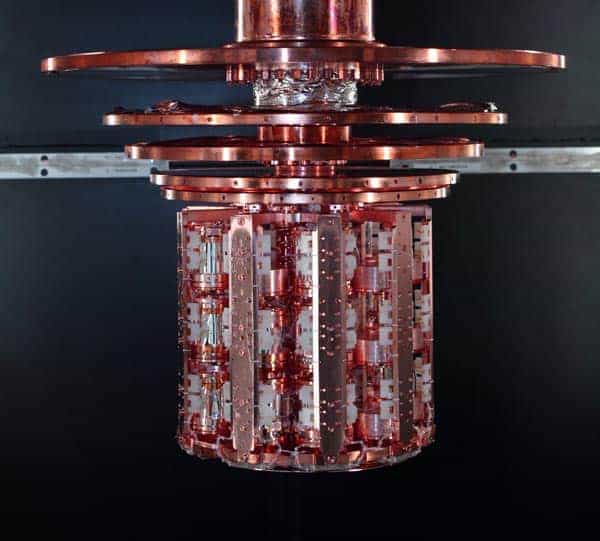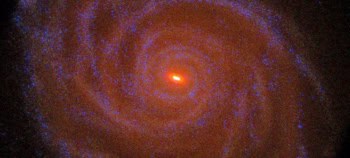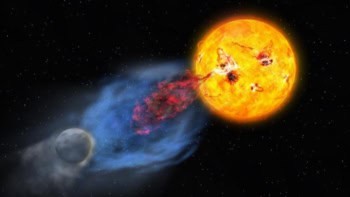
Physicists are finally closing in on dark matter, the elusive substance thought to make up most of the matter in the universe. Either that, or they’re being misled by some unknown source of error.
That seemed to be the general idea, after the team behind the CRESST (or the Cryogenic Rare Event Search with Superconducting Thermometers) experiment in Italy announced on Tuesday that it had uncovered signals that could be interpreted as dark matter. These signals join possible traces of dark matter seen by two other direct-detection experiments in recent years, which suggests that evidence is mounting. The trouble is, physicists cannot agree whether the different signals match up or not.
“There is no consensus – which is good, I think,” says Rafael Lang, a physicist at Columbia University, New York, and member of another dark-matter experiment called XENON. “My personal feeling is that we are not understanding the detectors well enough. At the same time, I think that if any of these [signals] were dark matter, that would be fantastic … It would be ‘easy’ dark matter, one that likes to interact with us and tell us where it’s coming from, what it’s doing.”
Tricky search
Dark matter is thought to make up more than 80% of the universe’s matter. However, it is invisible and has so far only been inferred by the gravitational pull that it exerts on normal matter. Physicists think that it probably takes the form of weakly interacting massive particles, or WIMPs.
To spot these WIMPs directly, researchers have built detectors in underground labs where the low background noise ought to allow any signals to stand out. The biggest underground lab is at Gran Sasso, a mountain in central Italy, home to various dark-matter experiments such as DAMA, XENON and CRESST. For just over a decade, the team behind the DAMA experiment has claimed to see a WIMP signal – an annual modulation that would fit in with the Earth orbiting with and against the prevailing “wind” of dark matter in our galaxy. Last year, the CoGeNT collaboration, based in the Soudan mine in Minnesota, US, reported hundreds of blips in their detectors that could also be WIMPs.
Such dark-matter detectors work when a WIMP collides with an atomic nuclei, which then recoils, producing a trademark scintillation, or flash. CRESST has an advantage here, in that its detectors use three types of nuclei – calcium, tungsten and oxygen – bonded together in calcium tungstate. Each of these nuclei has a different mass, which effectively means that dark matter can be probed in three different ways. For instance, if the recoil comes from a tungsten nucleus – the heaviest of the three – that probably means the WIMP itself is heavy.
Speaking at a conference in Munich on Tuesday, the CRESST team announced that they ran their latest experiment from June 2009 to April 2011, using 2.4 kg of calcium tungstate. They recorded 67 WIMP-like signals, of which roughly half could not be explained by any background phenomena. A preprint of their analysis is available at the arXiv preprint server.
Background to blame?
The question is whether the signal from CRESST, which points to a relatively light WIMP, can be reconciled with results from other direct-detection experiments. DAMA and CoGeNT have both recorded positive signals, but not for WIMPs with the same range of properties. Worse, the CRESST signal suggests a WIMP with properties that had previously been ruled-out by experiments such as XENON and CDMS, the latter of which is based at the Soudan mine.
“It is clear that it is difficult to reconcile the results from CDMS, XENON, CRESST and other dark-matter experiments with a single, simple dark-matter interpretation,” says Jodi Cooley, a physicist at the Southern Methodist University in Texas, US, who works on the CDMS experiment. “So, that leaves one of two possibilities. Either dark matter is behaving in a very strange way that we do not understand, or the backgrounds in the CRESST experiment are not well enough understood. To me, these results underline the need to have experiments that are capable of operating a mode where background subtraction is not necessary.”
Not everyone agrees. The properties of a detected WIMP are estimates, liable to change with varying assumptions about the equipment used. This leads some physicists to believe that the positive results can be reconciled.
Dan Hooper of the Fermi National Accelerator Laboratory near Chicago, US, is one such physicist. “The new results from CRESST are indeed very exciting,” he says. “They seem to be roughly compatible with previous signals reported by the DAMA and CoGeNT collaborations. The null results from CDMS and XENON do introduce some tension into this interpretation, although I am of the opinion that a self-consistent picture could come out of this complicated situation.” Members of the CRESST team could not be reached for comment.
More experience necessary
It will take time to understand whether the CRESST signals do, indeed, signify WIMP collisions and this requires a better understanding of the detector equipment itself. But the experimentalists are hopeful.
“[The CRESST signal] looks to me to be consistent with an ‘additional’ background,” says Alex Murphy, a physicist at the University of Edinburgh who works on the ZEPLIN dark-matter experiment in Boulby Mine, UK. “At the sensitivity level that the latest detectors are reaching, extremely rare interactions, involving multiple scattering, pile up, partially dead regions of detectors, edge effects and combinations of all of these, begin to be important. Even backgrounds have backgrounds!”



